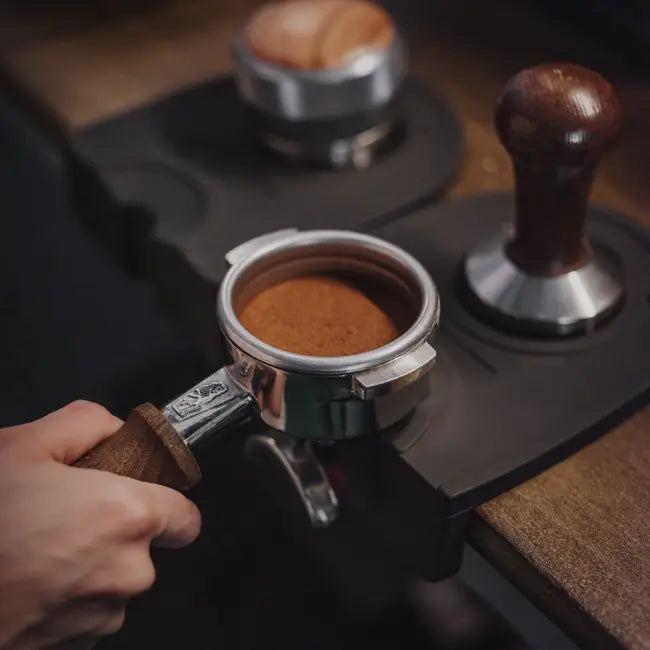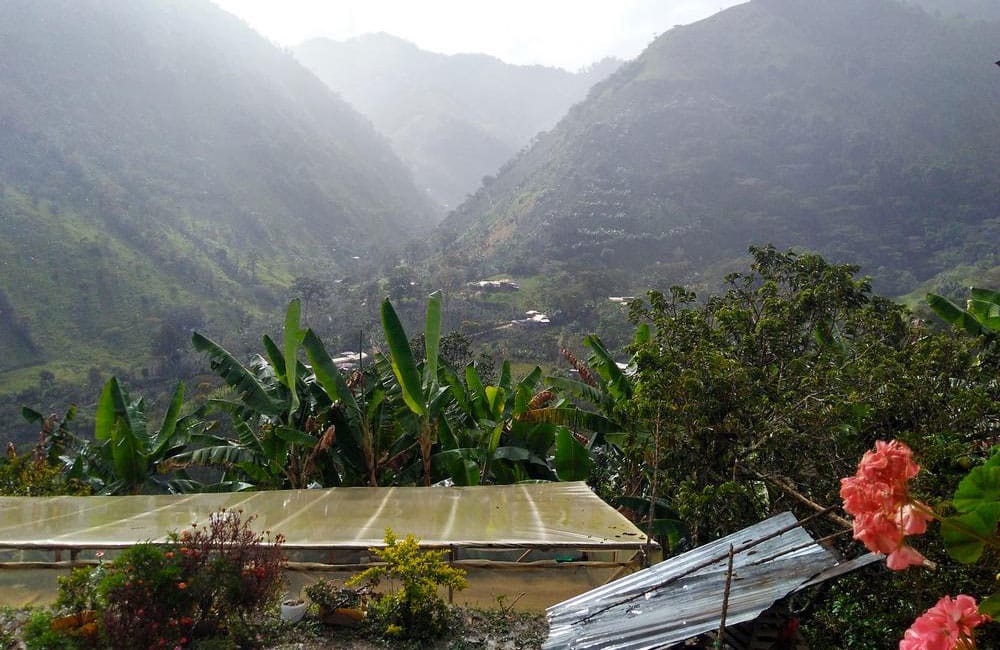 El café de Biftu Gudina es procesado usando el método lavado. Una vez en la estación de lavado, los frutos son clasificados a mano y se descartan los frutos inmaduros o excesivamente maduros antes de pasarlos por la máquina despulpadora ‘eco-pulper’ Penagos (esta máquina ayuda a reducir el uso de agua excesivo). A continuación, los granos se dejan en remojo durante unas 8 horas. El tratamiento de aguas residuales de la cooperativa se basa en una forma natural de filtración a través de una parcela de pasto vetiver antes de pasar por los pozos y finalmente a la tierra. A continuación, los granos se secan al sol durante 10 a 14 días en camas africanas elevadas y se vuelven a clasificar cuidadosamente a mano.
El café de Biftu Gudina es procesado usando el método lavado. Una vez en la estación de lavado, los frutos son clasificados a mano y se descartan los frutos inmaduros o excesivamente maduros antes de pasarlos por la máquina despulpadora ‘eco-pulper’ Penagos (esta máquina ayuda a reducir el uso de agua excesivo). A continuación, los granos se dejan en remojo durante unas 8 horas. El tratamiento de aguas residuales de la cooperativa se basa en una forma natural de filtración a través de una parcela de pasto vetiver antes de pasar por los pozos y finalmente a la tierra. A continuación, los granos se secan al sol durante 10 a 14 días en camas africanas elevadas y se vuelven a clasificar cuidadosamente a mano.
¿Qué es el Pink Bourbon?
El Pink Bourbon es una variedad de café arábica que se caracteriza por el inusual color rosado de sus cerezas maduras. Este rasgo lo distingue de otras variedades más comunes como el Bourbon Rojo o el Bourbon Amarillo.
Pero su atractivo no se limita a su apariencia; el Pink Bourbon ofrece un perfil de sabor excepcionalmente complejo, con notas florales, frutales y una acidez brillante que lo hace destacar en competiciones de catación.
 El café de Biftu Gudina es procesado usando el método lavado. Una vez en la estación de lavado, los frutos son clasificados a mano y se descartan los frutos inmaduros o excesivamente maduros antes de pasarlos por la máquina despulpadora ‘eco-pulper’ Penagos (esta máquina ayuda a reducir el uso de agua excesivo). A continuación, los granos se dejan en remojo durante unas 8 horas. El tratamiento de aguas residuales de la cooperativa se basa en una forma natural de filtración a través de una parcela de pasto vetiver antes de pasar por los pozos y finalmente a la tierra. A continuación, los granos se secan al sol durante 10 a 14 días en camas africanas elevadas y se vuelven a clasificar cuidadosamente a mano.
El café de Biftu Gudina es procesado usando el método lavado. Una vez en la estación de lavado, los frutos son clasificados a mano y se descartan los frutos inmaduros o excesivamente maduros antes de pasarlos por la máquina despulpadora ‘eco-pulper’ Penagos (esta máquina ayuda a reducir el uso de agua excesivo). A continuación, los granos se dejan en remojo durante unas 8 horas. El tratamiento de aguas residuales de la cooperativa se basa en una forma natural de filtración a través de una parcela de pasto vetiver antes de pasar por los pozos y finalmente a la tierra. A continuación, los granos se secan al sol durante 10 a 14 días en camas africanas elevadas y se vuelven a clasificar cuidadosamente a mano.
Origen e Historia del Pink Bourbon
Aunque su nombre sugiere una relación directa con la familia Bourbon, los estudios genéticos han demostrado que el Pink Bourbon no es un híbrido de Bourbon Rojo y Amarillo, como se pensaba inicialmente. Su descubrimiento se remonta a Colombia, donde fue identificado por primera vez en la región de Huila.
Se creía que era una mutación espontánea entre variedades Bourbon, pero investigaciones recientes han revelado que en realidad se trata de una variedad landrace de Etiopía, es decir, una variedad autóctona que crece de forma silvestre en los bosques etíopes. A pesar de este descubrimiento, el nombre "Pink Bourbon" ha perdurado, consolidándose en el mercado internacional.
 El café de Biftu Gudina es procesado usando el método lavado. Una vez en la estación de lavado, los frutos son clasificados a mano y se descartan los frutos inmaduros o excesivamente maduros antes de pasarlos por la máquina despulpadora ‘eco-pulper’ Penagos (esta máquina ayuda a reducir el uso de agua excesivo). A continuación, los granos se dejan en remojo durante unas 8 horas. El tratamiento de aguas residuales de la cooperativa se basa en una forma natural de filtración a través de una parcela de pasto vetiver antes de pasar por los pozos y finalmente a la tierra. A continuación, los granos se secan al sol durante 10 a 14 días en camas africanas elevadas y se vuelven a clasificar cuidadosamente a mano.
El café de Biftu Gudina es procesado usando el método lavado. Una vez en la estación de lavado, los frutos son clasificados a mano y se descartan los frutos inmaduros o excesivamente maduros antes de pasarlos por la máquina despulpadora ‘eco-pulper’ Penagos (esta máquina ayuda a reducir el uso de agua excesivo). A continuación, los granos se dejan en remojo durante unas 8 horas. El tratamiento de aguas residuales de la cooperativa se basa en una forma natural de filtración a través de una parcela de pasto vetiver antes de pasar por los pozos y finalmente a la tierra. A continuación, los granos se secan al sol durante 10 a 14 días en camas africanas elevadas y se vuelven a clasificar cuidadosamente a mano.
¿Pink Bourbon es Realmente un Bourbon?
No. A pesar de su nombre, el Pink Bourbon no está genéticamente relacionado con la familia Bourbon. Estudios de ADN realizados en 2017 y 2023 confirmaron que se trata de una variedad de café con origen en Etiopía, más cercana genéticamente a las variedades silvestres etíopes que a los Bourbon tradicionales.
Este descubrimiento ha generado un debate en la industria sobre la importancia de los nombres vernáculos en el café. Aunque el término "Bourbon" puede inducir a error, su uso ha facilitado la comercialización de esta variedad debido a su asociación con cafés de alta calidad.
 El café de Biftu Gudina es procesado usando el método lavado. Una vez en la estación de lavado, los frutos son clasificados a mano y se descartan los frutos inmaduros o excesivamente maduros antes de pasarlos por la máquina despulpadora ‘eco-pulper’ Penagos (esta máquina ayuda a reducir el uso de agua excesivo). A continuación, los granos se dejan en remojo durante unas 8 horas. El tratamiento de aguas residuales de la cooperativa se basa en una forma natural de filtración a través de una parcela de pasto vetiver antes de pasar por los pozos y finalmente a la tierra. A continuación, los granos se secan al sol durante 10 a 14 días en camas africanas elevadas y se vuelven a clasificar cuidadosamente a mano.
El café de Biftu Gudina es procesado usando el método lavado. Una vez en la estación de lavado, los frutos son clasificados a mano y se descartan los frutos inmaduros o excesivamente maduros antes de pasarlos por la máquina despulpadora ‘eco-pulper’ Penagos (esta máquina ayuda a reducir el uso de agua excesivo). A continuación, los granos se dejan en remojo durante unas 8 horas. El tratamiento de aguas residuales de la cooperativa se basa en una forma natural de filtración a través de una parcela de pasto vetiver antes de pasar por los pozos y finalmente a la tierra. A continuación, los granos se secan al sol durante 10 a 14 días en camas africanas elevadas y se vuelven a clasificar cuidadosamente a mano.
Características de la Planta de Pink Bourbon
El cafeto de Pink Bourbon presenta características morfológicas distintivas:
Altura: Puede variar entre plantas altas y más compactas, lo que refleja su diversidad genética.
Cerezos Rosados: Su color es resultado de una mutación genética que afecta la síntesis de antocianinas, los pigmentos responsables del color.
Susceptibilidad: Es menos resistente a enfermedades como la roya del café en comparación con otras variedades más comerciales.
A pesar de sus desafíos agronómicos, su potencial en taza lo hace muy atractivo para los caficultores que buscan diferenciarse en el mercado de café de especialidad.
 El café de Biftu Gudina es procesado usando el método lavado. Una vez en la estación de lavado, los frutos son clasificados a mano y se descartan los frutos inmaduros o excesivamente maduros antes de pasarlos por la máquina despulpadora ‘eco-pulper’ Penagos (esta máquina ayuda a reducir el uso de agua excesivo). A continuación, los granos se dejan en remojo durante unas 8 horas. El tratamiento de aguas residuales de la cooperativa se basa en una forma natural de filtración a través de una parcela de pasto vetiver antes de pasar por los pozos y finalmente a la tierra. A continuación, los granos se secan al sol durante 10 a 14 días en camas africanas elevadas y se vuelven a clasificar cuidadosamente a mano.
El café de Biftu Gudina es procesado usando el método lavado. Una vez en la estación de lavado, los frutos son clasificados a mano y se descartan los frutos inmaduros o excesivamente maduros antes de pasarlos por la máquina despulpadora ‘eco-pulper’ Penagos (esta máquina ayuda a reducir el uso de agua excesivo). A continuación, los granos se dejan en remojo durante unas 8 horas. El tratamiento de aguas residuales de la cooperativa se basa en una forma natural de filtración a través de una parcela de pasto vetiver antes de pasar por los pozos y finalmente a la tierra. A continuación, los granos se secan al sol durante 10 a 14 días en camas africanas elevadas y se vuelven a clasificar cuidadosamente a mano.
¿Dónde se Cultiva el Pink Bourbon?
El Pink Bourbon se cultiva principalmente en Colombia, especialmente en el departamento de Huila, aunque también ha ganado popularidad en otras regiones de América Latina.
Condiciones Óptimas para su Cultivo:
Altitud: Entre 1,700 y 2,200 msnm.
Clima: Temperaturas moderadas con estaciones secas definidas.
Suelo: Rico en nutrientes, idealmente de origen volcánico, lo que contribuye a su complejidad de sabor.
Estas condiciones permiten que el cafeto desarrolle todo su potencial aromático y gustativo.
 El café de Biftu Gudina es procesado usando el método lavado. Una vez en la estación de lavado, los frutos son clasificados a mano y se descartan los frutos inmaduros o excesivamente maduros antes de pasarlos por la máquina despulpadora ‘eco-pulper’ Penagos (esta máquina ayuda a reducir el uso de agua excesivo). A continuación, los granos se dejan en remojo durante unas 8 horas. El tratamiento de aguas residuales de la cooperativa se basa en una forma natural de filtración a través de una parcela de pasto vetiver antes de pasar por los pozos y finalmente a la tierra. A continuación, los granos se secan al sol durante 10 a 14 días en camas africanas elevadas y se vuelven a clasificar cuidadosamente a mano.
El café de Biftu Gudina es procesado usando el método lavado. Una vez en la estación de lavado, los frutos son clasificados a mano y se descartan los frutos inmaduros o excesivamente maduros antes de pasarlos por la máquina despulpadora ‘eco-pulper’ Penagos (esta máquina ayuda a reducir el uso de agua excesivo). A continuación, los granos se dejan en remojo durante unas 8 horas. El tratamiento de aguas residuales de la cooperativa se basa en una forma natural de filtración a través de una parcela de pasto vetiver antes de pasar por los pozos y finalmente a la tierra. A continuación, los granos se secan al sol durante 10 a 14 días en camas africanas elevadas y se vuelven a clasificar cuidadosamente a mano.
Métodos de Cultivo y Procesamiento del Pink Bourbon
El Pink Bourbon requiere un manejo agronómico cuidadoso debido a su susceptibilidad a enfermedades y la necesidad de mantener la pureza genética.
Métodos de Procesamiento Comunes:
Lavado: Resalta la acidez brillante y la claridad de sabores.
Natural: Potencia las notas frutales y dulces.
Honey: Un equilibrio entre la limpieza del lavado y la frutalidad del natural.
Fermentación Anaeróbica: Aporta complejidad y perfiles únicos con notas especiadas.
Cada método influye de manera diferente en el perfil final de la taza, lo que permite una gran variedad de experiencias sensoriales.
 El café de Biftu Gudina es procesado usando el método lavado. Una vez en la estación de lavado, los frutos son clasificados a mano y se descartan los frutos inmaduros o excesivamente maduros antes de pasarlos por la máquina despulpadora ‘eco-pulper’ Penagos (esta máquina ayuda a reducir el uso de agua excesivo). A continuación, los granos se dejan en remojo durante unas 8 horas. El tratamiento de aguas residuales de la cooperativa se basa en una forma natural de filtración a través de una parcela de pasto vetiver antes de pasar por los pozos y finalmente a la tierra. A continuación, los granos se secan al sol durante 10 a 14 días en camas africanas elevadas y se vuelven a clasificar cuidadosamente a mano.
El café de Biftu Gudina es procesado usando el método lavado. Una vez en la estación de lavado, los frutos son clasificados a mano y se descartan los frutos inmaduros o excesivamente maduros antes de pasarlos por la máquina despulpadora ‘eco-pulper’ Penagos (esta máquina ayuda a reducir el uso de agua excesivo). A continuación, los granos se dejan en remojo durante unas 8 horas. El tratamiento de aguas residuales de la cooperativa se basa en una forma natural de filtración a través de una parcela de pasto vetiver antes de pasar por los pozos y finalmente a la tierra. A continuación, los granos se secan al sol durante 10 a 14 días en camas africanas elevadas y se vuelven a clasificar cuidadosamente a mano.
Perfil de Sabor del Pink Bourbon
El Bourbon Rosado destaca por su perfil de sabor elegante y complejo:
Aroma: Floral e intenso, con notas de jazmín y rosas.
Sabor: Frutas tropicales, durazno, frambuesa y miel.
Acidez: Brillante, similar a cítricos dulces.
Cuerpo: Sedoso y cremoso.
Su dulzor natural y acidez equilibrada lo convierten en un café perfecto para métodos de extracción filtrados como V60 o Chemex.
¿Por Qué es Tan Especial y Cotizado?
Su rareza: La dificultad de cultivarlo y su limitada producción lo hacen exclusivo.
Perfil sensorial: Su sabor es excepcionalmente complejo y dulce.
Reconocimiento internacional: Ha ganado popularidad en competencias de baristas y catadores.
Desafíos y Oportunidades para los Caficultores
Cultivar Pink Bourbon presenta varios desafíos:
- Baja resistencia a enfermedades.
- Requiere más cuidados agronómicos.
- Mayor dificultad en la cosecha debido a la identificación del punto óptimo de maduración.
Sin embargo, su alto valor en el mercado compensa estas dificultades, ofreciendo oportunidades para los caficultores que apuestan por la calidad.
Curiosidades sobre el Bourbon Rosado
- ¿Por qué se llama Pink Bourbon si no es un Bourbon? Es un nombre comercial que se mantuvo por su atractivo en el mercado.
- Origen misterioso: A pesar de ser cultivado en Colombia, su origen genético está en Etiopía.
- ¿Existe un verdadero Bourbon Rosado? Hasta ahora, no se ha identificado un Bourbon genéticamente puro con cerezas rosadas.
Cómo Preparar y Disfrutar un Buen Pink Bourbon
Métodos Recomendados:
V60: Resalta su acidez brillante y notas florales.
Chemex: Aporta claridad y elegancia en la taza.
Aeropress: Intensifica sus notas dulces y frutales.
Conclusión: ¿Vale la Pena Probar el Pink Bourbon?
Definitivamente sí. El Pink Bourbon o Bourbon Rosado ofrece una experiencia sensorial única, tanto por su complejidad de sabores como por su historia fascinante. Ya seas un barista experimentado o un amante del café, este café es una joya que merece ser explorada.
Descubre, disfruta y comparte el encanto de una de las variedades más especiales del café de especialidad.









